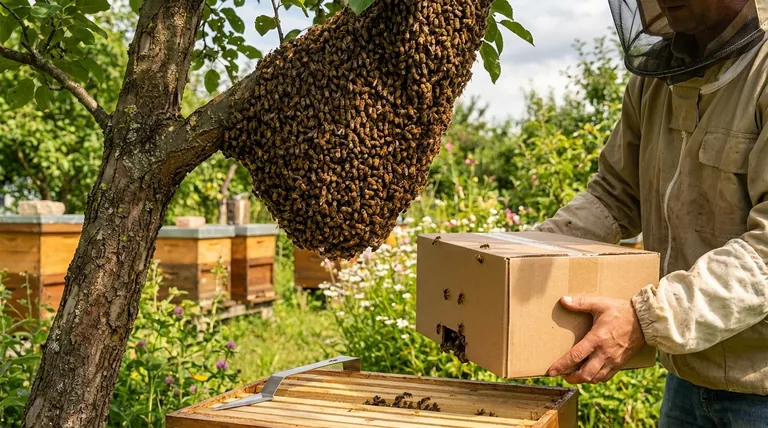In essence, swarming is the natural method of honey bee colony reproduction. It is a deliberate process where a single, successful colony splits into two, with the original queen leaving with a large group of worker bees to establish a new nest, while a new queen prepares to take over the original hive.
Swarming should not be viewed as an act of hive abandonment but as a calculated reproductive strategy. It is the definitive sign of a strong, healthy colony that has outgrown its home and is driven by instinct to propagate its genetics.

The Triggers: Why a Colony Decides to Swarm
A honey bee colony's decision to swarm is not sudden. It is a response to a specific set of environmental and internal signals that indicate the time is right for expansion.
The Primary Catalyst: Congestion
The most significant trigger for swarming is overcrowding. When the hive becomes packed with bees, brood, and honey, there is little room for the queen to lay new eggs.
This congestion also dilutes the distribution of the queen's pheromones, which are chemical signals that maintain colony cohesion and suppress the workers' instinct to raise new queens.
An Abundance of Resources
Swarming is a resource-intensive endeavor. It typically occurs in the spring or early summer when nectar and pollen are plentiful.
This abundance signals to the colony that the environment can support both the parent hive and a new daughter colony, making the risk of splitting worthwhile.
The Role of Queen Age
As a queen ages, her egg-laying rate naturally declines, and her pheromone output weakens. This subtle chemical shift is a cue for the workers to begin preparations for "supersedure," or queen replacement, which often coincides with swarming.
The Process: A Coordinated Split
Once the decision to swarm is made, the colony executes a series of remarkable and highly organized steps.
Preparing a Successor
Worker bees begin by building several special, peanut-shaped wax structures called queen cells. The reigning queen lays eggs in these cells, and the workers feed the resulting larvae a protein-rich diet of royal jelly to ensure they develop into new queens.
The Departure
Crucially, the original queen and about half of the worker bees leave the hive before the new virgin queens emerge from their cells. This group, known as the primary swarm, gorges on honey to have fuel for the journey.
The Temporary Cluster
The swarm flies a short distance and forms a dense, buzzing cluster, typically on a tree branch or other structure. This temporary bivouac serves to protect the queen at its center.
The Search for a New Home
From this cluster, several hundred experienced "scout bees" fly out in search of a suitable new cavity for a permanent nest. When a scout finds a promising location, it returns to the cluster and performs a "waggle dance" to communicate its discovery.
Other scouts inspect the proposed sites, and through a process of competing dances, the colony reaches a democratic consensus on the best option. Once a decision is made, the entire swarm takes flight to its new home.
The Risks and Rewards of Swarming
Swarming is the pinnacle of a honey bee colony's success, but it is a strategy fraught with peril for both the departing swarm and the parent hive.
High Stakes for the Swarm
The swarm is incredibly vulnerable. It has a limited supply of honey reserves and must find a permanent, sheltered home quickly to survive bad weather and build a new nest before winter.
The Challenge for the Parent Colony
The original colony is left with a drastically reduced workforce and must successfully raise, mate, and begin laying with a new queen. If the new queen is lost on her mating flight or fails to return, the colony is doomed.
The Ultimate Reward: Genetic Continuation
Despite the risks, the reward is the continuation of the colony's lineage. Successful swarming means one superorganism has become two, doubling the presence of its genes in the environment.
How to Interpret a Swarm
Understanding the motivation behind swarming changes how we perceive this natural event.
- If your primary focus is on colony survival: View swarming as a high-risk, high-reward reproductive act, directly analogous to a single organism giving birth.
- If your primary focus is on bee behavior: Recognize it as one of the most sophisticated examples of collective intelligence and democratic decision-making in the animal kingdom.
- If you are a beekeeper: Interpret swarming not as a failure, but as a sign of a thriving colony that requires management to either prevent the loss of bees or capture the swarm to start a new hive.
Ultimately, a swarm is the physical embodiment of a honey bee colony's success and its powerful, unwavering instinct to endure.
Summary Table:
| Aspect | Key Insight |
|---|---|
| Definition | The natural method of colony reproduction; a strong colony splits in two. |
| Primary Trigger | Overcrowding and congestion within the hive. |
| Main Risk | High vulnerability for the swarm and a reduced workforce for the parent hive. |
| Key Takeaway | A sign of a successful, healthy colony, not a failure. |
Is your apiary prepared for swarming season? As a thriving colony is a sign of success, managing swarms is key to maximizing your honey production and hive health. HONESTBEE supplies commercial apiaries and beekeeping equipment distributors with the high-quality, wholesale-focused supplies needed to manage swarms effectively and expand your operations. Let our expertise support your success. Contact our team today to discuss your beekeeping supply needs.
Visual Guide

Related Products
- HONESTBEE Professional Long Handled Hive Tool with Precision Cutting Blade
- Professional Dual-End Stainless Steel Hive Tool for Beekeeping
- HONESTBEE Professional Multi-Functional Hive Tool with Ergonomic Wood Handle
- Multi-Function Plier-Style Frame Grip Hive Tool
- Professional Stainless Steel Pry-Bar Hive Tool
People Also Ask
- How should beekeepers handle bees when using a hive tool? Master Calm, Deliberate Techniques
- What is the hive tool used for? The Essential Multi-Tool for Every Beekeeper
- What are the features of a regular hive tool? The Essential Multi-Tool for Every Beekeeper
- How can a hive tool be used to remove propolis and burr comb? Master Hive Maintenance for a Healthy Colony
- What is a hive tool and what are its uses? Master Your Hive Inspections with the Essential Beekeeper's Tool



















